VIEWPOINTS – The New York City Ballet principal women dazzle in a pair of all-Balanchine programs
- By drediman
- February 8, 2016
- No Comments
The current roster of New York City Ballet principal women is taking the dance world by storm. A recent viewing of two all-Balanchine programs showed these artists reaching new heights in their respective careers. Here are my thoughts.
“Walpurgisnacht Ballet”
Music by Charles Francois Gounod (from Faust)
Created in 1980
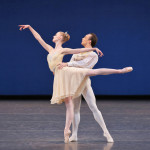 I was never always a fan of of Teresa Reichlen’s dancing. Despite possessing striking proportions – this tall dancer’s arms and legs seem to go on forever – her dancing initially struck me as safe and tentative, lacking the excitement of some of her peers. But in recent years (particularly since seeing her charged Dewdrop in The Nutcracker a few seasons ago), I’ve come to appreciate Teresa Reichlen as an artist. On Friday night in Balanchine’s “Walpurgisnacht Ballet”, I found Ms. Reichlen’s dancing to be in the beginning a tad detached, and memories of the Ms. Reichlen of old came rushing back. I needn’t have worried. She quickly found her groove (all it seemed to take was for her to, literally, let her hair down and for the the quickening music to take her soul to more potent territories) and was in majestic form in time for the dance’s pulsating climax set to music from Gounod’s opera, Faust.
I was never always a fan of of Teresa Reichlen’s dancing. Despite possessing striking proportions – this tall dancer’s arms and legs seem to go on forever – her dancing initially struck me as safe and tentative, lacking the excitement of some of her peers. But in recent years (particularly since seeing her charged Dewdrop in The Nutcracker a few seasons ago), I’ve come to appreciate Teresa Reichlen as an artist. On Friday night in Balanchine’s “Walpurgisnacht Ballet”, I found Ms. Reichlen’s dancing to be in the beginning a tad detached, and memories of the Ms. Reichlen of old came rushing back. I needn’t have worried. She quickly found her groove (all it seemed to take was for her to, literally, let her hair down and for the the quickening music to take her soul to more potent territories) and was in majestic form in time for the dance’s pulsating climax set to music from Gounod’s opera, Faust.
“Sonatine”
Music by Maurice Ravel
Created in 1975
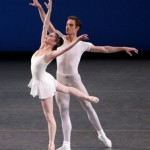 Megan Fairchild has always had the goods. She looks the part – her body is ideal for classical ballet and she has the technique. But something seemed to have been missing from her dancing: stage presence and personality. I could see fear in her eyes every time she stepped onto the stage. That all seemed to change when she was (surprisingly) cast as Ivy Smith for a lengthy stint, at least by ballet standards, in the recent Broadway revival of the Jerome Robbins classic musical On the Town (high profile dancers like City Ballet’s own Tiler Peck and ABT superstar Misty Cope also took a crack at the role later in the revival’s run). Since then, Ms. Fairchild has finally looked more at home in the spotlight. Indeed, I’ve rarely seen her as charismatic, confident, and free as she was in Friday night’s performance of the rarely-performed Balanchine duet “Sonantine”.
Megan Fairchild has always had the goods. She looks the part – her body is ideal for classical ballet and she has the technique. But something seemed to have been missing from her dancing: stage presence and personality. I could see fear in her eyes every time she stepped onto the stage. That all seemed to change when she was (surprisingly) cast as Ivy Smith for a lengthy stint, at least by ballet standards, in the recent Broadway revival of the Jerome Robbins classic musical On the Town (high profile dancers like City Ballet’s own Tiler Peck and ABT superstar Misty Cope also took a crack at the role later in the revival’s run). Since then, Ms. Fairchild has finally looked more at home in the spotlight. Indeed, I’ve rarely seen her as charismatic, confident, and free as she was in Friday night’s performance of the rarely-performed Balanchine duet “Sonantine”.
“Mozartiana”
Music by Peter Ilyitch Tschaikovsky
Created in 1981
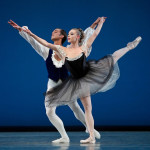 Is there another dancer more magnetic, more regal than present-day Sara Mearns? If so, I’m hard-pressed to name anyone else who’s in the same league. Ms. Mearns is not only a dancer with a palpable sense of drama and supreme musicality. She’s more than that – what she has is the uncanny ability to control time and space, even when she’s standing completely still. Whenever she’s onstage, you simply cannot take your eyes off of her. Each moment in the choreography is imbued with mysterious depth, almost as if she’s casting a spell, step-by-step. Her performance on Friday in “Mozartiana” did not disappoint. Because of Ms. Mearns, this charming Balanchine ballet registered on a more lusciously sinister note – her Preghiera, together with Troy Schumacher’s Gigue, seemed play the role of Pied Pipers to the Menuet, leading and seducing them down a path to an impossible ideal (Ms. Mearns herself).
Is there another dancer more magnetic, more regal than present-day Sara Mearns? If so, I’m hard-pressed to name anyone else who’s in the same league. Ms. Mearns is not only a dancer with a palpable sense of drama and supreme musicality. She’s more than that – what she has is the uncanny ability to control time and space, even when she’s standing completely still. Whenever she’s onstage, you simply cannot take your eyes off of her. Each moment in the choreography is imbued with mysterious depth, almost as if she’s casting a spell, step-by-step. Her performance on Friday in “Mozartiana” did not disappoint. Because of Ms. Mearns, this charming Balanchine ballet registered on a more lusciously sinister note – her Preghiera, together with Troy Schumacher’s Gigue, seemed play the role of Pied Pipers to the Menuet, leading and seducing them down a path to an impossible ideal (Ms. Mearns herself).
“Symphony in C”
Music by George Bizet
Created in 1947
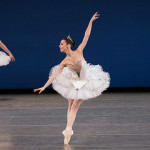 Friday’s performance of Balanchine’s brilliant “Symphony in C” featured two significant turns. After a series of injuries, it’s nice to see Ana Sophia Scheller back dancing better than ever. She’s a petite dancer with precise technique and a sparkling lightness that’s easy on the eyes. She shined in the ballet’s first movement (allegro vivo). In the sensuous second movement (adagio), Sterling Hyltin, once again showed why she’s one of City Ballet’s treasures. Like Sara Mearns, Ms. Hyltin, despite her slight physical stature, possesses the ability to use choreography as a conduit to greater truths. All-in-all, this “Symphony in C” was a smashing way to end the first all-Balanchine program.
Friday’s performance of Balanchine’s brilliant “Symphony in C” featured two significant turns. After a series of injuries, it’s nice to see Ana Sophia Scheller back dancing better than ever. She’s a petite dancer with precise technique and a sparkling lightness that’s easy on the eyes. She shined in the ballet’s first movement (allegro vivo). In the sensuous second movement (adagio), Sterling Hyltin, once again showed why she’s one of City Ballet’s treasures. Like Sara Mearns, Ms. Hyltin, despite her slight physical stature, possesses the ability to use choreography as a conduit to greater truths. All-in-all, this “Symphony in C” was a smashing way to end the first all-Balanchine program.
Music by “Ballo della Regina”
Giuseppe Verdi (from Don Carlo)
Created in 1978
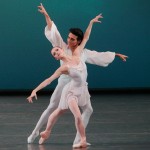 The second all-Balanchine program on Sunday afternoon got off to an inspired start with “Ballo della Regina” set to music from the great Verdi opera Don Carlo. The audience responded with audible disappointment when it was announced that the awesome Tiler Peck would not be dancing. In her stead, Megan Fairchild admirably stepped up. If her performance here didn’t quite have the personality of Friday night’s performance in “Sonatine”, it was still a performance to applaud. It’s a pleasure to see a more confident and aggressive Ms. Fairchild up there, and I eagerly await to see how she further grows in authority as an artist.
The second all-Balanchine program on Sunday afternoon got off to an inspired start with “Ballo della Regina” set to music from the great Verdi opera Don Carlo. The audience responded with audible disappointment when it was announced that the awesome Tiler Peck would not be dancing. In her stead, Megan Fairchild admirably stepped up. If her performance here didn’t quite have the personality of Friday night’s performance in “Sonatine”, it was still a performance to applaud. It’s a pleasure to see a more confident and aggressive Ms. Fairchild up there, and I eagerly await to see how she further grows in authority as an artist.
“Kammermusik No. 2”
Music by Paul Hindemith
Created in 1978
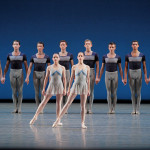 After the excitement of the other performances, I’m sorry to report that Rebecca Krohn and Abi Stafford were merely serviceable, even tired, in the modern, angular “Kammermusik No. 2”, a ballet that I in the past have loved. Indeed, the entire company – including the typically reliable male principals Adrian Danig-Waring and Ask la Cour – looked sluggish in this performance and seemed to struggle with keeping up with the staccato rhythms of Mr. Hindemith’s score. I suspect that this ballet would come across better in a “Black & White”-type program, in which the dancers aren’t asked to dramatically modify their dancing mid-program.
After the excitement of the other performances, I’m sorry to report that Rebecca Krohn and Abi Stafford were merely serviceable, even tired, in the modern, angular “Kammermusik No. 2”, a ballet that I in the past have loved. Indeed, the entire company – including the typically reliable male principals Adrian Danig-Waring and Ask la Cour – looked sluggish in this performance and seemed to struggle with keeping up with the staccato rhythms of Mr. Hindemith’s score. I suspect that this ballet would come across better in a “Black & White”-type program, in which the dancers aren’t asked to dramatically modify their dancing mid-program.
“Tschaikovsky Suite No. 3”
Music by Peter Ilyitch Tchaikovsky
Created in 1970
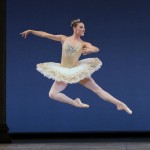 Despite my concerns regarding “Kammermusik No. 2”, Sunday’s all-Balanchine program ended on a glittering note with a performance of the classic “Tschaikovsky Suite No. 3”. In the first movement (élégie), Teresa Reichlen seemed at the top of her game, dancing with passion and reckless abandon. Her huge sweeping movements and free flowing mane were breathtaking to watch. The other important turn came from the Tiler Peck, who was in spectacularly fine form in the ballet’s glorious fourth and final movement (tema con variazioni). Ms. Peck once again displayed the brightness, unmatchable musicality, and effortlessness that has rightfully earned her the reputation of being one the finest dancers in her generation. You can almost always count on Ms. Peck to deliver the goods.
Despite my concerns regarding “Kammermusik No. 2”, Sunday’s all-Balanchine program ended on a glittering note with a performance of the classic “Tschaikovsky Suite No. 3”. In the first movement (élégie), Teresa Reichlen seemed at the top of her game, dancing with passion and reckless abandon. Her huge sweeping movements and free flowing mane were breathtaking to watch. The other important turn came from the Tiler Peck, who was in spectacularly fine form in the ballet’s glorious fourth and final movement (tema con variazioni). Ms. Peck once again displayed the brightness, unmatchable musicality, and effortlessness that has rightfully earned her the reputation of being one the finest dancers in her generation. You can almost always count on Ms. Peck to deliver the goods.
HIGHLY RECOMMENDED
ALL-BALANCHINE PROGRAMS (I & II)
Dance
New York City Ballet at the David H. Koch Theater
Each program is approximately 2 hours
Closed

 Copyright © 2024
Copyright © 2024
Leave a Reply